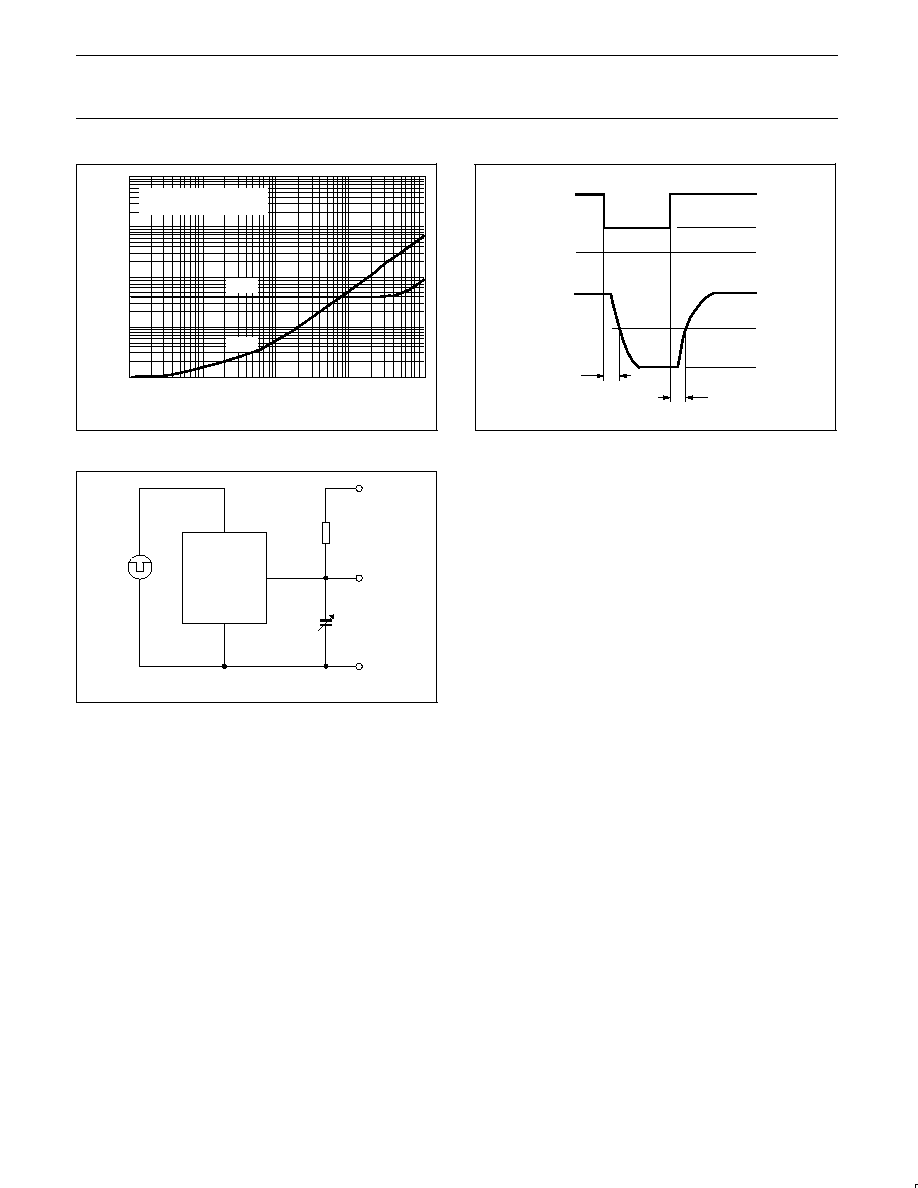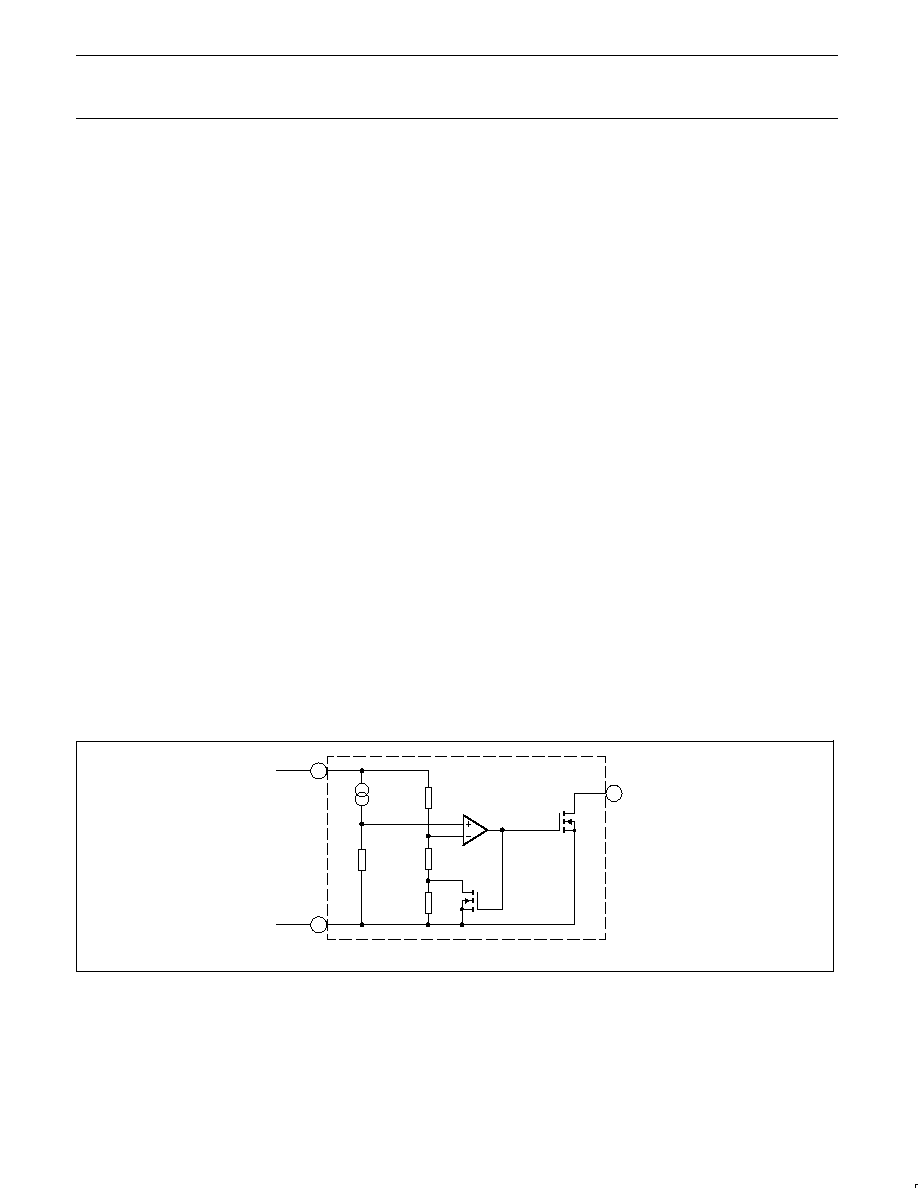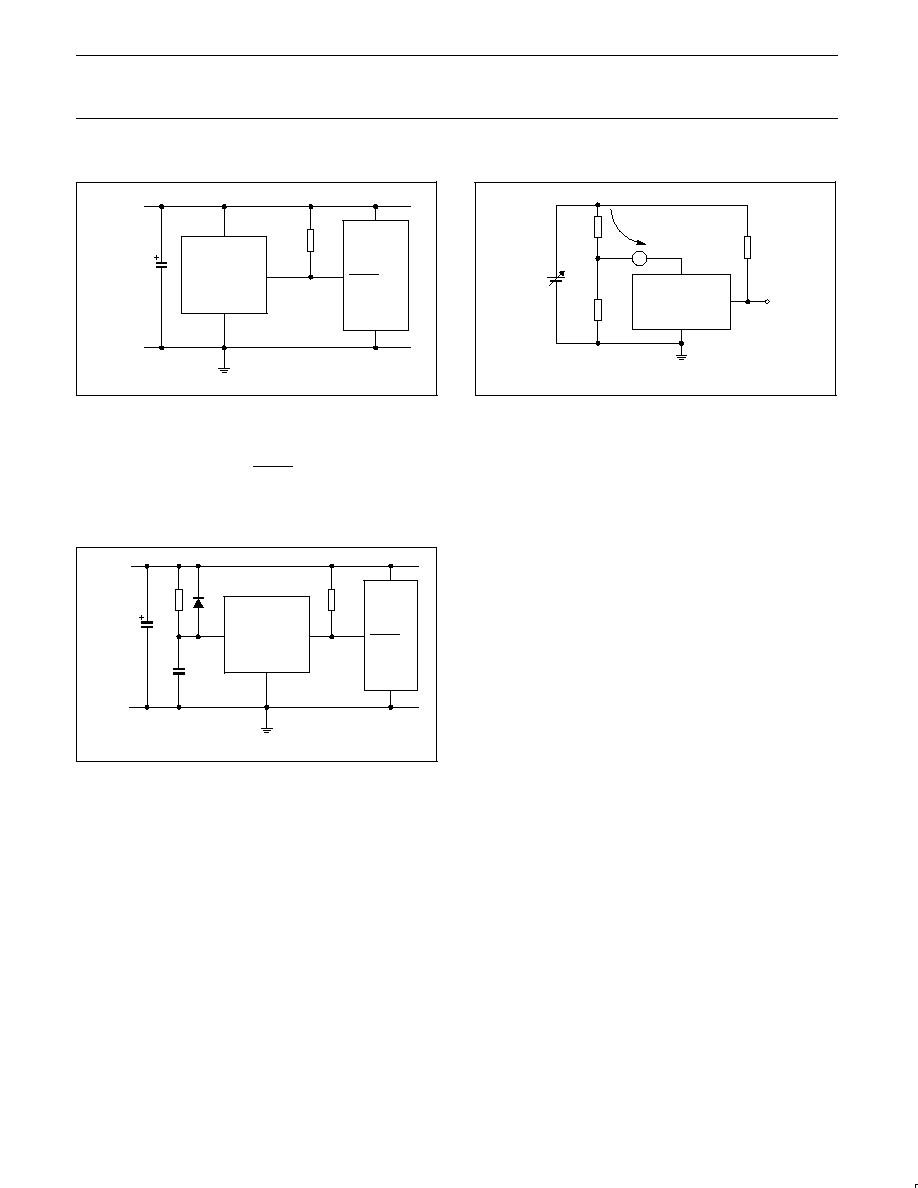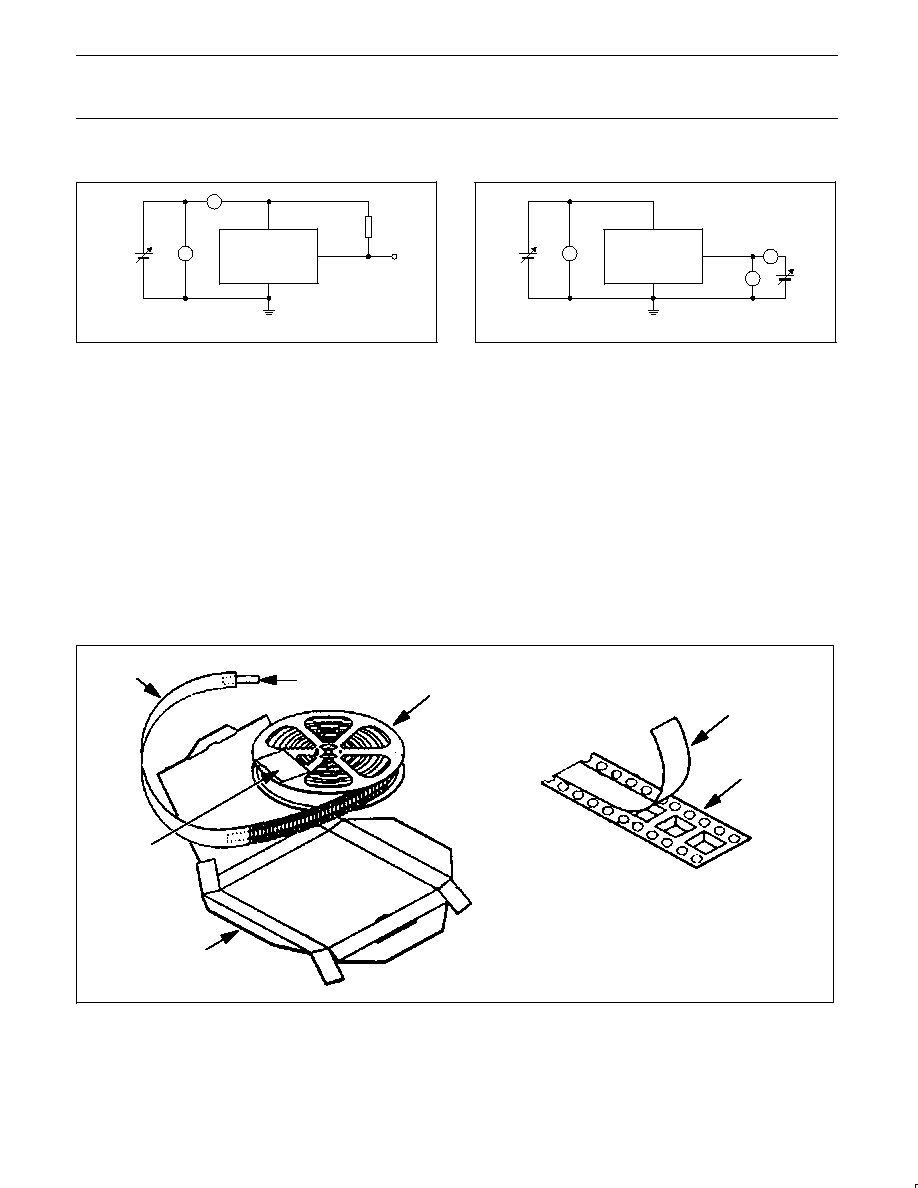Document Outline
- GENERAL DESCRIPTION
- FEATURES
- APPLICATIONS
- SIMPLIFIED SYSTEM DIAGRAM
- ORDERING INFORMATION
- PIN CONFIGURATION
- PIN DESCRIPTION
- MAXIMUM RATINGS
- DC ELECTRICAL CHARACTERISTICS
- TYPICAL PERFORMANCE CURVES
- TECHNICAL DESCRIPTION
- PACKING METHOD
- PACKAGE
- Data sheet status
- Definitions
- Disclaimers

Philips
Semiconductors
SA56606-XX
CMOS system reset
Product data
Supersedes data of 2001 Apr 24
File under Integrated Circuits, Standard Analog
2001 Jun 19
INTEGRATED CIRCUITS

Philips Semiconductors
Product data
SA56606-XX
CMOS system reset
2
2001 Jun 19
885≠2247 26559
GENERAL DESCRIPTION
The SA56606-XX is a CMOS device designed to generate a reset
signal for a variety of microprocessor and logic systems. Accurate
reset signals are generated during momentary power interruptions
or whenever power supply voltages sag to intolerable levels. An
Open Drain output topology is incorporated for adaptability to a wide
variety of logic and microprocessor applications. Several reset
threshold versions of the device are available.
The SA56606-XX is available in the SOT23-5 surface mount
package.
FEATURES
∑
12 V
DC
maximum operating voltage
∑
CMOS N-channel Open Drain output
∑
Offered in reset thresholds of
2.0, 2.7, 2.8, 2.9, 3.0, 3.1, 4.2, 4.3, 4.4, 4.5, 4.6, 4.7 V
DC
∑
Available in SOT23-5 surface mount package
APPLICATIONS
∑
Microcomputer systems
∑
Logic systems
∑
Battery monitoring systems
∑
Back-up power supply circuits
∑
Voltage detection circuits
SIMPLIFIED SYSTEM DIAGRAM
SL01313
V
DD
V
SS
V
REF
SA56606-XX
3
2
CPU
RESET
V
DD
V
SS
V
OUT
1
V
DD
V
SS
R
R
R
R
PU
Figure 1. Simplified system diagram.

Philips Semiconductors
Product data
SA56606-XX
CMOS system reset
2001 Jun 19
3
ORDERING INFORMATION
TYPE NUMBER
PACKAGE
TEMPERATURE
TYPE NUMBER
NAME
DESCRIPTION
RANGE
SA56606-XXGW
SOT23-5, SOT25, SO5
plastic small outline package; 5 leads (see dimensional drawing)
≠40 to +85
∞
C
NOTE:
The device has twelve detection voltage options, indicated by the
XX on the order code.
XX
DETECT VOLTAGE (Typical)
20
2.0 V
27
2.7 V
28
2.8 V
29
2.9 V
30
3.0 V
31
3.1 V
42
4.2 V
43
4.3 V
44
4.4 V
45
4.5 V
46
4.6 V
47
4.7 V
Part number marking
Each package is marked with a four letter code. The first three
letters designate the product. The fourth letter, represented by `x', is
a date tracking code. For example, AAKB is device AAK (the
SA56606-30 reset), produced in time period `B'.
Part number
Marking
SA56606-20
A A F x
SA56606-27
A A G x
SA56606-28
A A H x
SA56606-29
A A J x
SA56606-30
A A K x
SA56606-31
A A L x
SA56606-42
A A M x
SA56606-43
A A N x
SA56606-44
A A P x
SA56606-45
A A R x
SA56606-46
A A S x
SA56606-47
A A T x
PIN CONFIGURATION
SL01312
1
2
3
4
5
N/C
N/C
V
SS
V
DD
V
OUT
SA56606-XX
Figure 2. Pin configuration.
PIN DESCRIPTION
PIN
SYMBOL
DESCRIPTION
1
V
OUT
Reset High Output
2
V
DD
Positive Supply
3
V
SS
Ground. Negative Supply
4
N/C
No connection
5
N/C
No connection
MAXIMUM RATINGS
SYMBOL
PARAMETER
MIN.
MAX.
UNIT
V
DD
Power supply voltage
≠0.3
12
V
V
OUT
Output voltage
≠
V
SS
≠ 0.3
V
I
OUT
Output current
≠
50
mA
T
oper
Operating temperature
≠40
85
∞
C
T
stg
Storage temperature
≠40
125
∞
C
P
Power dissipation
≠
150
mW

Philips Semiconductors
Product data
SA56606-XX
CMOS system reset
2001 Jun 19
4
DC ELECTRICAL CHARACTERISTICS
Characteristics measured with T
amb
= 25
∞
C, unless otherwise specified.
SYMBOL
PARAMETER
CONDITIONS
TEST
CIRCUIT
MIN.
TYP.
MAX.
UNIT
V
S
Reset detection threshold
V
S
≠ 2%
V
S
V
S
+ 2%
V
V
S
Hysteresis
V
DD
= 0 V
V
S
+ 1.0 V
0 V
1
V
S
◊
0.03
V
S
◊
0.05
V
S
◊
0.08
V
V
S
/
T
Threshold voltage temperature
coefficient
≠40
∞
C
T
amb
+85
∞
C
1
Fig. 17
≠
±
0.01
≠
%/
∞
C
I
CC
Supply current
V
DD
= V
S
+ 1.0 V
≠
0.25
1.0
µ
A
I
OH
I
DS
leakage current when OFF
V
DD
= V
DS
= 10 V
≠
≠
0.1
µ
A
I
DS1
N-channel I
DS
output sink current 1
V
DS
= 0.5 V; V
DD
= 1.2 V
≠0.23
≠1.4
≠
mA
I
DS2
N-channel I
DS
output sink current 2
(for V
S
> 2.6 V)
V
DS
= 0.5 V; V
DD
= 2.4 V
2
Fig. 18
≠1.6
≠8.3
≠
mA
I
DS3
N-channel I
DS
output sink current 3
(for V
S
> 3.9 V)
V
DS
= 0.5 V; V
DD
= 3.6 V
≠3.2
≠14.7
≠
mA

Philips Semiconductors
Product data
SA56606-XX
CMOS system reset
2001 Jun 19
5
TYPICAL PERFORMANCE CURVES
SL01344
T
amb
, TEMPERATURE (
∞
C)
DD
, SUPPL
Y
CURRENT
(mA)
I
0.10
0.15
0.20
0.25
0.30
0.35
0.40
0.45
0.50
≠50
≠25
0
25
50
75
100
125
V
DD
= V
S
+ 1.0 V
NORMALIZED TO 25
∞
C
Figure 3. Supply current versus temperature.
SL01345
T
amb
, TEMPERATURE (
∞
C)
S
, NORMALIZED
THRESHOLD
(V)
V
≠50
≠25
0
25
50
75
100
125
≠0.20
≠0.10
+0.10
+0.20
+0.15
≠0.15
≠0.05
+0.05
V
S
V
CC
FALLING
V
S
NORMALIZED TO 25
∞
C
Figure 4. Detection threshold versus temperature.
SL01346
T
amb
, TEMPERATURE (
∞
C)
S(HYS)
, DETECTION HYSTERESIS (mV)
V
≠50
≠25
0
25
50
75
100
125
0
50
100
150
200
V
S(HYS)
= V
SH
≠ V
SL
(V
CC
RISING ≠ V
CC
FALLING)
Figure 5. Detection hysteresis versus temperature.
T
amb
, AMBIENT TEMPERATURE (
∞
C)
≠50
≠25
0
25
50
75
100
125
DS
, OUTPUT
FET
CURRENT
(mA)
I
0
0.5
1.0
1.5
2.0
2.5
3.0
N-CHANNEL
SL01317
V
DS
= 0.5 V
Figure 6. Output FET current versus temperature.
SL01348
V
DD
, SUPPLY VOLTAGE (V)
OUT
, OUTPUT
VOL
T
AGE
(V)
V
0
1.0
2 .0
3.0
4.0
5.0
6.0
0
1.0
2.0
3.0
4.0
5.0
V
S(HYS)
SL
DETECTION (V )
T
AMB
= 25
∞
C
TYPICAL CHARACTERISTIC.
DETECTION AND RELEASE
VOLTAGE POINTS DEPEND ON
THE SPECIFIC DEVICE TYPE.
SH
RELEASE (V )
Figure 7. Output voltage versus supply voltage
SL01349
V
DD
, SUPPLY VOLTAGE (V)
DD
,
SUPPL
Y
CURRENT
(
A)
I
1.0
2.0
3.0
4.0
5.0
6.0
7.0
8.0
9.0
10
0
0
0.1
0.2
0.3
0.4
0.5
0.6
µ
T
AMB
= 25
∞
C
Figure 8. Supply current versus supply voltage

Philips Semiconductors
Product data
SA56606-XX
CMOS system reset
2001 Jun 19
6
SL01350
C
L
, OUTPUT LOAD CAPACITANCE (
µ
F)
PHL
,
PROP
AGA
TION
DELA
Y
( s)
t
µ
PLH
, t
T
AMB
= 25
∞
C
(SEE FIGURES 10 AND 11)
10
5
10
4
10
3
10
2
10
1
10
≠5
10
≠4
10
≠3
10
≠2
10
≠1
t
PHL
t
PLH
Figure 9. Propagation delay versus output load C
SL01351
V
S
+ 2.0 V
1.2 V
V
SS
7.0 V
3.5 V
V
SS
INPUT SIGNAL
OUTPUT SIGNAL
t
PHL
t
PLH
Figure 10. Propagation delay measurements
SL01322
SA56606-XX
V
DD
V
SS
INPUT
SIGNAL
R
PU
= 100 k
C
L
= 10 pF to 0.1
µ
F
7.0 V
OUTPUT
V
SS
Figure 11. Propagation delay measurement circuit

Philips Semiconductors
Product data
SA56606-XX
CMOS system reset
2001 Jun 19
7
TECHNICAL DESCRIPTION
The SA56606-XX is a CMOS device designed to provide power
source monitoring and a system reset function in the event the
supply voltage sags below an acceptable level for the system to
reliably operate. The device is designed to generate a compatible
reset signal for a wide variety of microprocessor and logic systems.
The SA56606 can operate at voltages up to 12 volts. The series
includes several versions providing precision threshold voltage reset
values of 2.0, 2.7, 2.8, 2.9, 3.0, 3.1, 4.2, 4.6 and 4.7 V. The reset
threshold incorporates a typical hysteresis of (V
S
◊
0.05) volts to
prevent erratic resets from being generated.
The output of the SA56606 utilizes a low side open drain topology,
which requires an external pull-up resistor (R
PU
) to the V
DD
power
source. Although this may be regarded as a disadvantage, it is an
advantage in many sensitive applications because the open drain
output cannot source reset current to a microprocessor when both
are operated from a common supply. For this reason the SA56606
offers a safe inter-connect to a wide variety of microprocessors.
The SA56606 operates at very low supply currents, typically
0.25
µ
A, while offering a high precision of threshold detection (
±
2%).
Figure 12 is a functional block diagram of the SA56606. The internal
reference source voltage (V
REF
) is typically 0.8 V over the operating
temperature range. The reference voltage is connected to the
non-inverting input of the threshold comparator, while the inverting
input monitors the supply voltage through a resistor divider network
made up of R
1
, R
2
, and R
3
. The output of the threshold comparator
drives the output Open Drain N-Channel FET of the device TR
1
).
When the supply voltage sags to the threshold detection voltage, the
resistor divider network supplies a voltage to the inverting input of
the threshold comparator, which is less than that of V
REF
, causing
the output of the comparator to go to a HIGH output state. This
causes the low side N-Channel FET to be active ON, pulling its
drain voltage to a LOW state. The device adheres to a true
input/output logic protocol: the output goes LOW when input is LOW
(below threshold) and output goes HIGH when input is HIGH (above
threshold).
The low side N-Channel FET (TR
2
) establishes threshold hysteresis
by turning ON whenever the threshold comparator's output goes to
a HIGH state (when V
DD
sags to or below the threshold level). TR
2
's
turning ON causes additional current to flow through resistors R
1
and
R
2
, causing the inverting input of the threshold comparator to be
pulled even lower. For the comparator to reverse its output polarity
and turn OFF TR
2
, the V
DD
source voltage must overcome this
additional pull-down voltage present on the comparator's inverting
input. The differential voltage required to do this establishes the
hysteresis voltage of the sensed threshold voltage. Typically it is
(V
S
◊
0.05) volts.
When the V
DD
voltage sags, and is at or below the Detection
Threshold (V
SL
), the device will assert a Reset LOW output at or
very near ground potential. As the V
DD
voltage rises from
(V
DD
< V
SL
) to V
SH
or higher, the Reset is released and the output
follows V
DD
. Conversely, decreases in V
DD
from (V
DD
> V
SL
) to V
SL
or lower cause the output to be pulled to ground.
Hysteresis Voltage = Release Voltage ≠ Detection Threshold Voltage
V
HYS
= V
SH
≠ V
SL
where:
V
SH
= V
SL
+ V
HYS
V
REF
(R
1
+ R
2
) / R
2
V
SL
= V
REF
(R
1
+ R
2
+ R
3
) / (R
2
+ R
3
)
When V
DD
drops to levels below the minimum operating voltage,
typically less than 0.95 volts, the output is undefined and output
reset LOW assertion is not guaranteed. At this level of V
DD
the
output will try to rise to V
DD
.
The V
REF
voltage is typically 0.8 V. The devices are fabricated using
a high resistance CMOS process and utilize high resistance R
1
, R
2
,
and R
3
values requiring very small amounts of current. This
combination achieves very efficient low power performance over the
full operating temperature.
SL01323
V
DD
V
SS
V
REF
SA56606-XX
V
OUT
1
R
2
R
1
R
R
3
TR
1
TR
2
3
2
Figure 12. Functional diagram.

Philips Semiconductors
Product data
SA56606-XX
CMOS system reset
2001 Jun 19
8
Timing diagram
The timing diagram shown in Figure 13 depicts the operation of the
device. Letters A≠J on the TIME axis indicate specific events.
A:
At `A', V
DD
begins to increase. Also the V
OUT
voltage initially
increases but abruptly decreases when V
DD
reaches the level
(approximately 0.8 V) that activates the internal bias circuitry and
RESET is asserted.
B:
At `B', V
DD
reaches the threshold level of V
SH
. At this point the
device releases the hold on the V
OUT
reset. The Reset output V
OUT
tracks V
DD
as it rises above V
SH
(assuming the reset pull-up resistor
R
PU
is connected to V
DD
). In a microprocessor based system these
events release the reset from the microprocessor, allowing the
microprocessor to function normally.
C≠D:
At `C', V
DD
begins to fall, causing V
OUT
to follow. V
DD
continues to fall until the V
SL
undervoltage detection threshold is
reached at `D'. This causes a reset signal to be generated (V
OUT
Reset goes LOW).
D≠E:
Between `D' and `E', V
DD
starts rising.
E:
At `E', V
DD
rises to the V
SH
. Once again, the device releases
the hold on the V
OUT
reset. The Reset output V
OUT
tracks V
DD
as it
rises above V
SH
.
F≠G:
At `F', V
DD
is above the upper threshold and begins to fall,
causing V
OUT
to follow it. As long as V
DD
remains above the V
SH
,
no reset signal will be triggered. Before V
DD
falls to the V
SH
, it
begins to rise, causing V
OUT
to follow it. At `G', V
DD
returns to
normal.
H:
At event `H' V
DD
falls until the V
SL
undervoltage detection
threshold point is reached. At this level, a RESET signal is
generated and V
OUT
goes LOW.
J:
At `J' the V
DD
voltage has decreased until normal internal circuit
bias is unable to maintain a V
OUT
reset. As a result, V
DD
may rise to
less than 0.8 V. As V
DD
decreases further, V
OUT
reset also
decreases to zero.
SL01354
V
DD
V
OUT
TIME
V
SH
V
SL
0
0
A
B
C
G
H
J
D
E
F
V
S
Figure 13. Timing diagram.

Philips Semiconductors
Product data
SA56606-XX
CMOS system reset
2001 Jun 19
9
Application information
SL01371
SA56606-XX
V
DD
SUPPLY
GND
V
DD
V
SS
V
OUT
RESET
CPU
R
PU
Figure 14. Conventional reset application.
The Power ON Reset Circuit shown in Figure 15 is an example of
how to obtain a stable reset condition upon power-up. If the power
supply voltage rises abruptly, the RESET may go HIGH momentarily
when V
DD
is below the minimum operating voltage (0.95 V). To
overcome this, a resistor (R) is placed between positive supply and
the V
DD
pin with a capacitor from the V
DD
pin to ground.
SL01372
SA56606-XX
V
DD
SUPPLY
GND
V
DD
V
SS
V
OUT
RESET
CPU
R
PU
D
C
R
Figure 15. Power ON reset circuit.
SL01373
SA56606-XX
OUTPUT
R
12
R
11
V
SUPPLY
A
V
DD
V
SS
CURRENT CHANGES
R
PU
Figure 16. High impedance supply operating problems.
Significant voltage variations of V
DD
may occur when the device is
operated from high impedance power sources. When the device
asserts or releases a reset, V
DD
variations are produced as a result
of the voltage drop developed across R
11
due to the current
variations through the resistor R
11
(representing the supply
impedance). If the V
DD
variations are large, such that they exceed
the Detection Hysteresis, the output of the device can oscillate from
a HIGH state to a LOW state. The user should avoid using high
impedance V
DD
sources to prevent such situations.

Philips Semiconductors
Product data
SA56606-XX
CMOS system reset
2001 Jun 19
10
Test circuits
SL01374
SA56606-XX
V
DD
A
V
DD
V
SS
V
R
PU
100 k
V
OUT
Figure 17. Test circuit 1.
SL01375
SA56606-XX
V
DD
V
DD
V
SS
V
V
OUT
V
A
V
DS
Figure 18. Test circuit 2.
PACKING METHOD
The SA56606-XX is packed in reels, as shown in Figure 19.
SL01305
TAPE DETAIL
COVER TAPE
CARRIER TAPE
REEL
ASSEMBLY
TAPE
GUARD
BAND
BARCODE
LABEL
BOX
Figure 19. Tape and reel packing method

Philips Semiconductors
Product data
SA56606-XX
CMOS system reset
2001 Jun 19
11
SOT23-5: plastic small outline package; 5 leads; body width 1.5 mm
1.35
1.2
1.0
0.025
0.55
0.41
0.22
0.08
3.00
2.70
1.70
1.50
0.55
0.35

Philips Semiconductors
Product data
SA56606-XX
CMOS system reset
2001 Jun 19
12
Definitions
Short-form specification -- The data in a short-form specification is extracted from a full data sheet with the same type number and title. For
detailed information see the relevant data sheet or data handbook.
Limiting values definition -- Limiting values given are in accordance with the Absolute Maximum Rating System (IEC 134). Stress above one
or more of the limiting values may cause permanent damage to the device. These are stress ratings only and operation of the device at these or
at any other conditions above those given in the Characteristics sections of the specification is not implied. Exposure to limiting values for extended
periods may affect device reliability.
Application information -- Applications that are described herein for any of these products are for illustrative purposes only. Philips
Semiconductors make no representation or warranty that such applications will be suitable for the specified use without further testing or
modification.
Disclaimers
Life support -- These products are not designed for use in life support appliances, devices or systems where malfunction of these products can
reasonably be expected to result in personal injury. Philips Semiconductors customers using or selling these products for use in such applications
do so at their own risk and agree to fully indemnify Philips Semiconductors for any damages resulting from such application.
Right to make changes -- Philips Semiconductors reserves the right to make changes, without notice, in the products, including circuits, standard
cells, and/or software, described or contained herein in order to improve design and/or performance. Philips Semiconductors assumes no
responsibility or liability for the use of any of these products, conveys no license or title under any patent, copyright, or mask work right to these
products, and makes no representations or warranties that these products are free from patent, copyright, or mask work right infringement, unless
otherwise specified.
Philips Semiconductors
811 East Arques Avenue
P.O. Box 3409
Sunnyvale, California 94088≠3409
Telephone 800-234-7381
©
Copyright Philips Electronics North America Corporation 2001
All rights reserved. Printed in U.S.A.
Date of release: 06-01
Document order number:
9397 750 08451
Philips
Semiconductors
Data sheet status
[1]
Objective data
Preliminary data
Product data
Product
status
[2]
Development
Qualification
Production
Definitions
This data sheet contains data from the objective specification for product development.
Philips Semiconductors reserves the right to change the specification in any manner without notice.
This data sheet contains data from the preliminary specification. Supplementary data will be
published at a later date. Philips Semiconductors reserves the right to change the specification
without notice, in order to improve the design and supply the best possible product.
This data sheet contains data from the product specification. Philips Semiconductors reserves the
right to make changes at any time in order to improve the design, manufacturing and supply.
Changes will be communicated according to the Customer Product/Process Change Notification
(CPCN) procedure SNW-SQ-650A.
Data sheet status
[1] Please consult the most recently issued datasheet before initiating or completing a design.
[2] The product status of the device(s) described in this data sheet may have changed since this data sheet was published. The latest information is available on
the Internet at URL http://www.semiconductors.philips.com.











